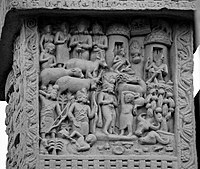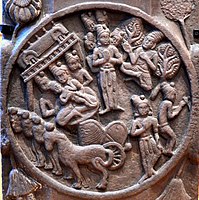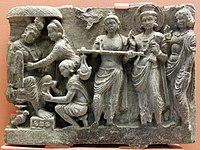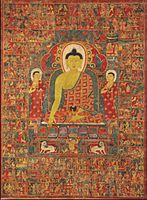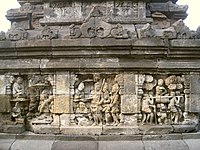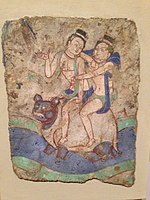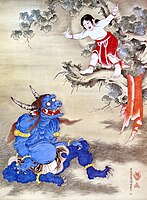Jatakatales

| Translations of Jātaka tales | |
|---|---|
| English | Birth history |
| Sanskrit | जातक (IAST:Jātaka) |
| Burmese | ဇာတက |
| Khmer | ជាតក (UNGEGN:Chéadâk) |
| Sinhala | ජාතක කථා (Jātaka Kathā) |
| Thai | ชาดก (RTGS:Chadok) |
| Glossary of Buddhism | |
TheJātaka(Sanskritfor "Birth-Related" or "Birth Stories" ) are a voluminous body of literature native to theIndian subcontinentwhich mainly concern the previous births ofGautama Buddhain both human and animal form. Jataka stories were depicted on the railings and torans of the stupas.[1][2]According to Peter Skilling, this genre is "one of the oldest classes of Buddhist literature."[3]Some of these texts are also considered great works of literature in their own right.[4]

In these stories, the future Buddha may appear as a king, anoutcast,adeva,an animal—but, in whatever form, he exhibits some virtue that the tale thereby inculcates.[5]Often, Jātaka tales include an extensive cast of characters who interact and get into various kinds of trouble - whereupon the Buddha character intervenes to resolve all the problems and bring about ahappy ending.The Jātaka genre is based on the idea that the Buddha was able to recollect all his past lives and thus could use these memories to tell a story and illustrate his teachings.[6]
For the Buddhist traditions, the jātakas illustrate the many lives, acts and spiritual practices which are required on the long path toBuddhahood.[1]They also illustrate the great qualities orperfectionsof the Buddha (such asgenerosity) and teach Buddhist moral lessons, particularly within the framework ofkarmaandrebirth.[7]Jātaka stories have also been illustrated inBuddhist architecturethroughout the Buddhist world and they continue to be an important element in popularBuddhist art.[7]Some of the earliest such illustrations can be found atSanchiandBharhut.
According to Naomi Appleton, Jātaka collections also may have played "an important role in the formation and communication of ideas aboutbuddhahood,karma and merit, and the place of the Buddha in relation to other buddhas andbodhisattvas."[7]According to the traditional view found in the PaliJātakanidana,a prologue to the stories, Gautama made a vow to become a Buddha in the future, in front past BuddhaDipankara.He then spent many lifetimes on the path to Buddhahood, and the stories from these lives are recorded as Jātakas.[8]
Jātakas are closely related to (and often overlap with) another genre of Buddhist narrative, theavadāna,which is a story of any karmically significant deed (whether by a bodhisattva or otherwise) and its result.[2][9]According to Naomi Appleton, some tales (such as those found in the second and fourth decade of theAvadānaśataka) can be classified as both a jātaka and an avadāna.[9]
Overview
[edit]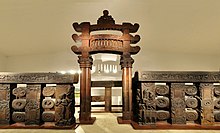
Dating
[edit]Jātakatales may be quite ancient. The term appears as part of a schema of Buddhist literary forms called the nine component genres of the Buddha's teaching (navaṅga-buddhasāsana), and depictions of them appear in earlyIndian art(as early as the second century BCE).[6][10]They are also widely represented in ancient Indianinscriptions.[11]According to Straube, "the presumably oldest specimens of fully elaborated narratives are dispersed throughout theVinayapiṭakasandSūtrapiṭakasof the canonical collections of thedifferent Buddhist schools.These texts are transmitted in various Indian dialects and stem from a prior oral tradition. "[2]
Furthermore, while these texts cannot be dated in a precise manner, "the fact that many narratives are passed on in almost identical form within the canons of the different schools shows that they date back to the time before theschismsbetween the schools took place. "[2]Sarah Shaw, writing on the PaliJātaka,states that the earliest part of theJātaka,the verse portions, are "considered amongst the very earliest part of the Pali tradition and date from the fifth century BCE" while "the later parts were incorporated during the period up to the third century CE."[8]
According toA. K. Warder,jātakaare the precursors to the various legendary biographies of the Buddha, which were composed at later dates.[12]Although manyjātakawere written from an early period, which describe previous lives of the Buddha, very little biographical material about Gautama's own life has been recorded.[12]Jātakatales also assimilate many traditional Indianfablesandfolklorethat are not specifically Buddhist. As the genre spread outside of India, it also drew on local folk tales.[6]
Literary features and themes
[edit]| Part ofa serieson |
| Buddhism |
|---|
 |
The Mahayana authorAsaṅgaprovides a working definition ofjātakain hisŚrāvakabhūmi:[13]
What isjātaka?That which relates the austere practices and bodhisattva practices of the Blessed One in various past births: this is calledjātaka.
The idea thatjātakaare taught in order to illustrate the bodhisattva path is an ancient one and is contained in sources like theMahavastu,which states: "the supreme ones [Buddhas], who are skilled in jātakas and other doctrines, teach the course of practice of a bodhisattva."[11]
Many jātakas are told with a common threefold plot schema which contains:[2]
- a “narrative in the present” (paccupannavatthu), with the Buddha and other figures,
- a “narrative in the past” (atītavatthu), a story from a past life of the Buddha
- a "link" (samodhāna) in which there is an “identification of the past protagonists with the present ones.”[2]
In thejātakafound in theSuttapitaka,which are almost always in prose, the Buddha is almost always depicted as a person of high rank in a past life (and not an animal). Some of these also include past lives of some of the Buddha's disciples.[2][11]One famous example is the PaliMahāparinirvāṇasūtra,which includes the story of Mahāsudarśana.[2]Unlike Sutra collections, Vinaya sources like theVinayavastucontain more varied jātakas, including ones in which the Buddha is depicted as an animal.[2]
Manyjātakacontain elements of both verse and prose. According to Martin Straube "the division into canonical verses and postcanonical prose points to the old Indian narrative form of ākhyāna, which has a fixed wording of the stanzas only, whereas the actual story is to be shaped anew during each oral performance."[2]The plots of thejātakarange from simplerAesopicstyle animal tales to longer more complex dramas which resemble epics or novels with intricate dialogue, characters and poetry. Despite the diversity of the plots and characters, they are all unified by the character of the heroic bodhisattva Gautama (whose identity is generally only revealed at the end of the story) and his struggles on the quest forawakening.[4]In spite of this, Gautama is not always the central character of all these stories and sometimes only plays a minor role.[14]Other recurring characters include importantdisciples of the Buddha,Devadatta(generally as anvillain) and members of Gautama's family, like his wifeYasodharāand sonRāhula.[14]
Another important element of the stories are the various Buddhist virtues, called perfections, that were cultivated by the bodhisattva Gautama throughout his previous lives, and which serve as the lessons taught by the jātakas.[15]Other jātakas, such as those found in theBuddhavaṃsa(Chronicle of Buddhas), focus on Gautama's meeting, serving and venerating past Buddhas and serve to place his bodhisattva path in a chronology of past Buddhas. These stories generally focus on acts of devotion to past Buddhas and how this generates muchmeritwhich many positive outcomes in the future.[9]A smaller number of jātakas illustrate various mistakes or bad actions that the bodhisattva committed in a past life (and the subsequent karmic retribution) and thus demonstrate the bodhisattva's past imperfections.[9]
Regarding the intended audience of these texts, Martin Straube notes that even though there is a widespread view that jātakas arose due to monks "catering to the needs and tastes of the illiterate lay practitioners of Buddhism as propagandistic means of preaching or converting" there is no historical evidence for this.[2]Instead, the opposite might be true, since "the prose portions of the Pali jātakas not infrequently have as their audience monks and nuns, who sometimes reach high levels of spiritual realization after listening to a jātaka story."[2]Naomi Appleton, in her analysis of the second and fourth decade of theAvadānaśataka,notes that both sets of stories "assume a monastic audience."[9]Likewise, Kate Crosby writes that "the format of the Jātaka in fact suggests that their original inclusion in the canonical collection was primarily for the benefit of monks."[16]Crosby notes that many of these stories are connected with monastic behavior and decorum, some of them are also meant to illustrate specific rules in theVinaya.In spite of this main intended audience, their simple format also made them easily adaptable for other uses. Thus, they were repackaged as artistic entertainment and teaching devices for laypersons, asparittas(protective chants) and aschronicle (vamsa) literature.[16]
Straube also notes that the rock caves ofAjantaand Bagh were inhabited by monks and it was them who ordered and directed the jātaka murals found there. There is also evidence from inscriptions on old stūpas at various Indian sites (such asSanchiandBharhut) with jātaka motifs which indicate that they were built due to the patronage of monks and nuns, some of them of high rank such asbhāṇaka(reciter).[2]Some scholars have also concluded that Jātaka reciters were part of their own division of reciters.[11]
History
[edit]Jātakas were originally transmitted inprakritlanguages and various forms of Sanskrit (fromclassicaltoBuddhist Hybrid Sanskrit). They were then translated into central Asian languages (such as Khotanese, Tocharian, Uighur, and Sogdian).[17]Various jātaka stories and source texts were also translated intoChineseandTibetanfor theTibetanandChinese Buddhist canons.[6]They were some of the first texts to be translated into Chinese.Kāng Sēnghuì(who worked inNankingc. 247) was one of the first Chinese translators of Jātakas. Perhaps his most influential translation is theScripture of the Collection of the Six Perfections.[17]
The various Indian Buddhist schools had different collections of jātakas. The largest known collection is theJātakatthavaṇṇanāof the Theravada school.[7]InTheravada Buddhism,the Jātakas are a textual division of thePāli Canon,included in theKhuddaka Nikayaof theSutta Pitaka.The termJātakamay also refer to a traditional commentaries (Atthakatha) on this book. The tales are dated between 300 BCE and 400 CE.[18]

The MahāsāṃghikaCaitikasects from theĀndhraregion also had Jātakas as part of their canon and they are known to have rejected some of the Theravāda Jātakas which dated past the time of KingAshoka.[19]The Caitikas claimed that their own Jātakas represented the original collection before the Buddhist tradition split into various lineages.[20]
In theNorthern Buddhist tradition,Jātakas eventually came to be composed in classicalSanskrit.Perhaps the most influential and important Sanskrit Jātaka text is theJātakamālā(Garland of Jātakas) of Āryaśūra which includes 34 Jātaka stories.[21]This work differs from earlier sources in that it is a highly sophisticated poem which makes use of various Sanskrit literary devices.[22]TheJātakamālāwas quite influential and was imitated by later authors who wrote their own jātakamālās,mainly Haribhaṭṭa and Gopadatta. These works are all written in a classical Sanskrit genre known as campū, which is a blend of prose and verse in various meters. The jātakamālās all also use the six perfections (pāramitā) as their main framework.[2]The influence of thejātakamālāscan be seen in theAjanta Cavecomplex, where illustrations of Jātakas are inscribed with quotes from Āryaśūra,[23]with script datable to the sixth century. TheJātakamālāwas also translated into Chinese in 434 CE.Borobudur,a massive 9th century Buddhist site inJava,contains depictions of all 34 Jatakas from theJātakamālā.[24]
Two other Sanskrit authors associated with the jātaka genre areKumāralāta(2nd century CE), author of theKalpanāmaṇḍitikā Dṛṣṭāntapaṅkti(Collection of Examples, Adorned with an Artistic Arrangement) and Saṅghasena's (date unknown)Pusa benyuan jing( bồ tát bổn duyên kinh;Sūtra of the Bodhisattva’s Avadānas). Both works exist only in Chinese translation (but there are Sanskrit fragments). These texts are a kind of predecessor to theJātakamālāand are less poetically sophisticated.[2]
Later Sanskrit authors continued to write in the genre. One such late text is Kṣemendra's (c. 1036–1065)Bodhisattvāvadānakalpalatā (Wish-Fulfilling Creeper Consisting in Avadānas of the Bodhisattva),a unique jātaka text written completely in verse. This work was influential on the Tibetan tradition.[2]
Jātaka are also important inTibetan Buddhism.They were one of the main sources of teaching and study for the popularKadamschool and later Tibetan authors produced abridged collections such asKarmapaRangjung Dorje'sHundred Birthsand Padma Chopel's summary of theAvadānakalpalatā.[25]
Classic Jātaka sources
[edit]


There are numerous sources for classic or canonical Jātaka tales, including:[26][2]
- The variousVinayapiṭakasandSūtrapiṭakasof the different canons of theearly Buddhist schools
- TheGandharan Buddhist textscontain many Jātaka narratives, though here they are more commonly termed pūrvayogas ( "former connection" )
- TheJātakatthavaṇṇanā,theTheravadaJātaka collection (part of theKhuddaka Nikāya) contains 547 Jātakas in mixed verse (gāthās) and prose and was collected around 500 CE. It is preceded by theNidānakathā,which is a biography of the Buddha which relates the stories to his life. It is the largest collection of Jātakas.[7]
- TheCariyāpiṭaka,a treatise on the bodhisattvaparamis,which includes 35 Jātakas.[6]
- Kumāralāta's (2nd century CE)Kalpanāmaṇḍitikā Dṛṣṭāntapaṅkti(Collection of Examples, Adorned with an Artistic Arrangement)
- Saṅghasena's (date unknown)Pusa benyuan jing( bồ tát bổn duyên kinh;Sūtra of the Bodhisattva’s Avadānas)
- An untitled collection of Sanskrit avadānas and jātakas found in theMerv oasisdated to the 5th century CE
- All the Pali commentaries (Aṭṭhakathā) on the Vinayapiṭaka and Suttapiṭaka contain Jātakas, the commentary on theDhammapadais a popular and well known source.
- TheBuddhavaṃsa(Chronicle of the Buddhas)a hagiographical text of the Sinhalese Theravada school
- TheMahāvastu(Great Event), a text of theMahāsāṅghikaLokottaravādaschool, contains many jātakas and avadānas
- TheVinayavastuof theMūlasarvāstivādaschool (which only survives in complete form in Tibetan translation), contains many jātakas and avadānas
- TheAvadānaśataka(The Hundred Avadānas,c. 2nd-6th century CE) contains various "Jātakāvadānas".[27]
- TheKarmaśataka
- TheDivyāvadāna(Heavenly Avadānas)
- The commentary on theUdānavargaby Prajñāvarman (8th century), which survives in Tibetan, contains numerous Jātakas
- Lalitavistara(The Play in Full), a biography of the Buddha containing various Jātakas.
- TheLiu du ji jing( lục độ tập kinh,Scripture of the Collection of the Six Perfections,Taisho 152), translated by Kang Senghui (?–280) in the third century CE.[28]
- Jātaka Sūtra(Sheng jing,Sinh kinh,Taisho Tripitaka154), a Chinese collection of 55 Jātakas translated into Chinese byDharmaraksa(3rd century).[28]
- TheXian yu jing( hiền ngu kinh, Taisho 202), with 69 stories.[28]
- TheDa zhuang yan lun jing( đại trang nghiêm luận kinh,*Kalpanāmaṇḍitikā,Taisho 201), translation byKumārajīva,with 90 stories.[28]
- TheJātakamālā(Garland of Jātakas),a series of classical Sanskritkāvyapoems by Āryaśūra (4th century), contains 34 Jātakas.[21]
- Haribhaṭṭa'sJātakamālā(Sanskrit)
- Sarvarakṣita'sMaṇicūḍajātaka(12th-century), aSāṃmitīyaschool text in 376 kāvya style stanzas.
- The Sutra of the Wise and the Foolish(Skt.Damamūka-nidāna-sūtra;Tibetan:mdo mdzangs blun;Chinese:hsien-yü ching)
- ManyMahayana sutrascontain Jātakas embedded into them. For example, theBodhisattvapiṭaka-sutracontains numerous Jātakas which are used to illustrate the various bodhisattva qualities.[29]Likewise, Jātakas are an important element in theLargePrajñāpāramitā sutra,theSuvarṇaprabhāsa sūtraand theBhadrakalpikasūtra.[3]TheBhadrakalpikasūtrahas a long section on the six perfections which includes around one hundred past life stories, including jātakas, pūrvayogas, andavadānas.[30]
- TheDà zhìdù lùn( đại trí độ luận ) a massiveMahāyānaBuddhisttreatise and commentary which survives in Chinese translation byKumarajiva,contains numerous Jātakas which are used to illustrate the six perfections as well as other topics.[31]
- Kṣemendra's (c. 1036–1065)Bodhisattvāvadānakalpalatā (Wish-Fulfilling Creeper Consisting in Avadānas of the Bodhisattva)
Late Jātakas
[edit]Within the Pali tradition, there are also many non-canonical Jātakas of later composition (some dated even to the 19th century) but these are treated as a separate category of literature from the "official" Jātaka stories that have been more or less formally canonized from at least the 5th century — as attested to in ampleepigraphicand archaeological evidence, such as extant illustrations inbas relieffrom ancient temple walls. Apocryphal Jātakas of the Pali Buddhist canon, such as those belonging to thePaññāsa Jātakacollection, have been adapted to fit local culture in certainSouth East Asiancountries and have been retold with amendments to the plots to better reflect Buddhist morals.[32][33]According to Kate Crosby, "there is also a collection of Jātaka of ten future Buddhas, beginning withMetteyya,which though less well-known today clearly circulated widely in the Theravada world. "[34]
There are also late compositions based on classic Jātakas, such as theKavsiḷumiṇa,a poem based on the Kusa Jātaka in archaicSinhalawritten KingParākkamabāhu II(13th century) and theMahachat kham luang,the ‘royal version' of theVessantara jātaka,which was composed at the court of King Paramatrailokanātha (c. 1482). The art of putting classic Jātakas intoThai verseremains a living tradition to this day.[35][34]
Important Jātakas
[edit]
In Theravada
[edit]The Theravāda Jātakas comprise 547 poems, arranged roughly by an increasing number of verses. According to Professor von Hinüber,[36]only the last 50 were intended to be intelligible by themselves, without commentary. The commentary gives stories in prose that it claims provide the context for the verses, and it is these stories that are of interest tofolklorists.Alternative versions of some of the stories can be found in another book of the Pali Canon, theCariyapitaka,and a number of individual stories can be found scattered around other books of the Canon. Many of the stories and motifs found in the Jātaka such as theRabbit in the Moonof the Śaśajātaka (Jataka Tales: no.316),[37]are found in numerous other languages and media.
For example, The Monkey and the Crocodile, The Turtle Who Couldn't Stop Talking and The Crab and the Crane that are listed below also famously featured in the HinduPanchatantra,the Sanskritniti-shastrathat ubiquitously influenced world literature.[38]Many of the stories and motifs are translations from the Pali but others are instead derived from vernacular oral traditions prior to the Pali compositions.[39]At theMahathupainSri Lankaall 550 Jataka tales were represented inside of the reliquary chamber.[40]Reliquaries often depict the Jataka tales.
InSoutheast Asia,the most important and widely known stories are the 10 stories of theMahānipāta jātaka(Ten Great Birth Stories).These tales are considered to be the ten final lives of thebodisattvaGautama and are said to have been the completion of the 10 paramis or perfections.[41]Of these, the Vessantara is the most popular. According to Peter Skilling, part of the reason for its popularity "was the pervasive belief, spread through the Māleyya-sutta and related literature, that by listening to this jātaka one could be assured of meeting the next Buddha,Metteya."[42]
The following list includes some important jātakas of the Pali tradition:
- The Ass in the Lion's Skin(Sīhacamma Jātaka)
- The Banyan Deer
- The Cock and the Cat(Kukkuṭa Jātaka)
- The Crab and the Crane
- The Elephant Girly-Face
- The Monkey King(Mahakapi Jataka)
- The Foolish, Timid Rabbit(Daddabha Jātaka)
- Four Harmonious Animals
- The Great Ape
- How the Turtle Saved His Own Life
- The Jackal and the Crow(Jambu-Khādaka Jātaka)
- The Jackal and the Otters(Dabbhapuppha Jātaka)
- The King's White Elephant
- The Lion and the Woodpecker(Javasakuṇa Jātaka)
- The Measure of Rice
- The Merchant of Seri
- The Monkey and the Crocodile
- The Ox Who Envied the Pig(Muṇika-Jātaka)
- The Ox Who Won the Forfeit
- The story of Romaka pigeon(Romaka Jātaka,previous life of the Buddha as a pigeon).[43]
- Prince Sattva
- The Princes and the Water-Sprite
- The Quarrel of the Quails
- The Swan with Golden Feathers(Suvaṇṇahaṃsa Jātaka)
- King Sibi
- King Dasharatha
- The Tiger, the Brahmin and the Jackal
- The Turtle Who Couldn't Stop Talking(Kacchapa Jātaka)
- The Twelve Sisters
- The Wise and the Foolish Merchant
- Vessantara Jataka
- Why the Owl Is Not King of the Birds
Āryaśūra's Jātakamālā
[edit]Āryaśūra'sJātakamālā,a very influential Sanskrit work that was depicted throughout the Buddhist world, contains the following Jātakas (which teach various virtues):[44]
- The Story of the Tigress (focuses on the perfection ofDāna,giving)
- The Story of the King of the Śibis (Dāna)
- The Story of the Small Portion of Gruel (Dāna)
- The Story of the Head of A Guild (Dāna)
- The Story of Aviṣahya, the Head of a Guild (Dāna)
- The Story of the Hare (Dāna)
- The Story of Agastya (Dāna)
- The Story of Maitrībala (Dāna)
- The Story of Viśvantara (Dāna)
- The Story of the Sacrifice (teachesŚīla,morality)
- The Story of Sakra (Karuṇā,compassion)
- The Story of the Brāhman (Hrī,self-respect)
- The Story of Unmādayantī (Dhairya, “self-control” )
- The Story of Supāraga (Sacca,truth)
- The Story of the Fish (Sacca, truth)
- The Story of the Quail's Young (Sacca, truth)
- The Story of the Jar (Vāra, excellence)
- The Story of the Childless One (Praviveka, seclusion)
- The Story of the Lotus-Stalks (Praviveka)
- The Story of the Treasurer (Hrī)
- The Story of Cuḍḍabodhi (Khanti,patient acceptance)
- The Story of the Holy Swans (Maitrī,loving-kindness)
- The Story of Mahābodhi (Khanti)
- The Story of the Great Ape (Anukampā, compassion)
- The Story of the Śarabha (Anukampā)
- The Story of the Ruru-Deer (Dayā, kindness)
- The Story of the Great Monkey (Anuvartinā, obedience)
- The Story of Kṣāntivādin (Khanti)
- The Story of the Inhabitant of the Brahmaloka (Anukampā)
- The Story of the Elephant (Karuṇā)
- The Story of Sutasoma (Satsaṁga, goodness)
- The Story of Ayogṛha (Saṃvega,spiritual urgency)
- The Story of the Buffalo (Khanti)
- The Story of the Woodpecker (Khanti)
Jātakas in art and culture
[edit]
Jātakas have been important as a way to spread Buddhist teachings and they were widely used as part of sermons, rituals, festivals, and various forms of art. Kate Crosby writes that they have been depicted in such varied forms as "apocryphal literature, vernacular retellings, performance, temple art, temporary street and festival art, films, comics, and cartoons."[45]The sponsorship of Jātaka recitations, copyings and art eventually grew to be seen as an act which generated merit for lay Buddhists. These acts are more common around important festivals likeVesak.[46]

The earliest archeological findings which depict Jātakas are the illustrations found in the on theBharhutstupa railing as well as atSanchi(c. late 2nd - 1st century BCE), which also include inscriptions.[47][2]After this, Jātakas appear at many Buddhist sites, like atAjanta.Similar Jātaka tales are found in murals ofSilk Roadsites of the pre-Tang period (ca. 421–640 C.E.), such as atKucha.They are also found in early Southeast Asian sites, especially atBagansites.Burmese Buddhismhas an extensive tradition of Jātaka illustration, one of the best examples being the illustrations found atAnanda Temple(which depicts 554 tales).[47]

Jātaka tales are often associated with specific locations. Originally, this applied to specific places in India, which served asBuddhist pilgrimage sites.Later traditions expanded this to include other places throughout the Buddhist world. According to Naomi Appleton, the fact that Jātaka tales lack specific references to specific places allowed them to be easily transported and re-localized. This flexibility contributed to the lasting popularity of the Jātakas.[48]This tradition of associating Jātaka tales with regions outside of India played an important part in the promotion and legitimisation of Buddhism in these regions.[48]
Thus, manystupasin Nepal and northern India are said to mark locations from the Jātaka tales. Chinese pilgrims likeXuanzangandFaxianreported several of these and discussed the stories connected with them. Sites discussed by these figures include the "four great stupas" as well as stupas inPushkalavati,Mangalura, Hadda Mountain, and Sarvadattaan.[49][50]
According to Naomi Appleton, the "four great stupas" visited byFaxian(337–422 CE) are:
the first (in ‘So-ho-to’) was where the Buddha ransomed the life of a dove with his own flesh; the second (inGandhāra) was where he gave away his eyes to a blind beggar; and the third and fourth (inTakshaśilā) were where he gave away his head to a man and his whole body to a starving tigress who was about to eat her own cubs, and where ‘kings, ministers, and peoples of all the kingdoms around vie with one another in making offerings’. A century later,Songyunwrites of the same four sites and also mentions a whole area associated with theVessantara-jātaka.[48]
Artistic depictions at major sites
[edit]Numerous Indian Buddhist archeological sites contain illustrations of Jātakas, and thus they are important artistic sources for Jātakas. Some of the main sites include:[26][2]
Other ancient sites outside of India which contain Jataka illustrations includeBorobudor,Dunhuang(theMogao caves),Polonnoruwa,Anuradhapura,Bagan city,andNakhon Pathom.[51]Jataka illustrations (especially of the last 10 stories of the canonical Pali collection) are widespread in the Theravada Buddhist world, adorning many temples,watsand key sites.[52]
Performance
[edit]According to the Chinese pilgrimYijing,who visited India in the 7th century, jātaka plays were performed ‘throughout the five countries of India’. This culture of performance spread to other regions as well.[25]
In Tibet, theViśvāntara-jātakawas transformed into a popular play called theDri med kun ldan.Other popular jataka plays include Nor bzaṅ or Sudhana and the story of Prince Maṇicūḍa (Lokānanda).[25]
InTheravadacountries, several of the longer tales such as "The Twelve Sisters"[53]and theVessantara Jataka[54]are still performed in dance,[55]theatre, puppetry,[52]and formal (quasi-ritual) recitation.[56]Such celebrations are associated with particular holidays on thelunar calendarused byThailand,Myanmar,Sri LankaandLaos.The recitation of theVessantara Jatakaremains an important ceremony remains an important ceremony in Theravada countries today.[57]
Gallery
[edit]-
Chaddanta Jataka, Sanchi
-
Sama Jataka, Sanchi
-
Syama Jataka Sanchi Stupa
-
Muga Pakha Jataka, Bharhut
-
Vessantara Jataka, Bharhut,Shunga period
-
Ajanta Cave 1, Mahajanaka Jataka
-
Hamsa jataka, Ajanta Caves
-
Ajanta cave 1, Chanpeyya Jataka
-
Sibi Jataka, Gandhara
-
Maha-Ummagga Jataka, Gandhara, 2nd century CE
-
Dipankara Jataka,Jamalgarhi
-
Tumshuq, Toqquz-sarai monastery, Visvamtara-jataka
-
Nine-colored deer jataka. Northern Wei.Mogao cave257
-
Khudda-bodhi-Jataka,Borobudur
-
Borobudur Jataka, Level 1 Balustrade, South Wall
-
Borobudur Jataka, Level 1 Balustrade, South Wall
-
Kucha,Turtle King Jataka
-
Modern era rendition of the Jataka tales by a Myanmar-based Vipassana center in India
-
Thai Vessantara Jataka Narrative Scroll
-
King Bhuridatta although caught by Alambayana maintains his Virtue, Bhuridatta Jataka
-
Thai Vessantara Jataka painting
-
"The snow-covered mountain child", by Soga Shōhaku circa 1764
-
The Story of King Mandhatar; The Story of King Candraprabha; The Tale of the Island of Vadaradvipa, Tibetan Painting from an Avadana Kalpalata Jataka Series
-
Tibetan Buddha Shakyamuni with "Jataka" Tales
-
Round Bowl Depicting the Vessantara Jataka - Silver Alloy - 18th-19th Century CE - Myanmar.
English Translations
[edit]The standard Pali collection of jātakas, withcanonicaltext embedded, has been translated byE. B. Cowelland others, originally published in six volumes byCambridge University Press(1895–1907) and reprinted in three volumes, by thePali Text Society(Bristol).[58]There are also numerous English translations of selections and individual stories from various sources.
Some of the main translations of jātakas available in English include:
- Bhikshu Dharmamitra, trans.Marvelous Stories from The Perfection of Wisdom: 130 Didactic Stories from Ārya Nāgārjuna’s Exegesis on the Great Perfection of Wisdom Sutra.Kalavinka Press, 2008.
- Burlingame, E.W., trans.,Buddhist Legends: Translated from the Original Pali Text of the Dhammapada Commentary,3 vols., HOS 28–30, Cambridge MA, 1921.
- Cowell, E.B., & R.A. Neil, eds.,The Jātaka or Stories of the Buddha’s Former Births,6 vols., Cambridge UK, 1895–1907.
- Cowell, E.B., & R.A. Neil, eds.,The Divyâvadâna: A Collection of Early Buddhist Legends,Cambridge UK, 1886.
- Cone, Margaret.The Perfect Generosity of Prince Vessantara: A Buddhist Epic,Clarendon Press (1977)
- Frye, Stanley.Sutra of the Wise and the Foolish,Library of Tibetan Works and Archives, 2006.
- Schiefner, F. Anton von.Tibetan Tales Derived from Indian Sources, translated from the Tibetan Kah Gyur(translated from the German by W.R.S. Ralston) (repr. Delhi: Sri Satguru, 1988)
- Hahn, M., ed.,Poetical Vision of the Buddha’s Former Lives: Seventeen Legends from Haribhaṭṭa’s Jātakamālā,New Delhi, 2011.
- Horner, I.B., trans.,The Minor Anthologies of the Pali Canon: Part III: Chronicle of Buddhas (Buddhavaṁsa) and Basket of Conduct (Cariyāpiṭaka),SBB 31, London, 1975.
- Horner, I.B., & H.S. Gehman, trans.,The Minor Anthologies of the Pali Canon: Part IV: Vimānavatthu: Stories of the Mansions,SBB 30, London 1974.
- I. B. Horner, trans,Minor AnthologiesIII, 2nd edition, 1975,Pali Text Society,Bristol.
- Jayawickrama, N.A., trans.,The Story of Gotama Buddha: The Nidāna-kathā of the Jātakaṭṭhakathā,Oxford, 1990.
- Jayawickrama, N.A., ed.,Buddhavaṃsa and Cariyāpiṭaka,PTSTS 166, London, 1974.
- Jones, J.J., trans.,The Mahāvastu: Translated from the Buddhist Sanskrit,3 vols., SBB 16, 18 & 19, London, 1949–1956.
- Kern, H., ed.,The Jātaka-Mālā or Bodhisattvāvadāna-Mālāby Ārya-Çūra, HOS 1, Boston, 1891.
- Khoroche, P., trans.,Once the Buddha Was a Monkey: Ārya Śūra’s Jātakamālā,London, 1989.
- Naomi Appleton,Many Buddhas, One Buddha: A Study and Translation of Avadānaśataka 1-40(Sheffield: Equinox, 2020)
- Naomi Appleton and Sarah Shaw (trans.),The Ten Great Birth Stories of the Bodhisatta(Chiang Mai: Silkworm Press, 2015).
- Appleton, Naomi; Shaw, Sarah.The Ten Great Birth Stories of the Buddha: The Mahanipata of the Jatakatthavanonoana;Silkworm Books, (2016)
- Ñāṇamoli,The Life of the Buddha according to the Pali Canon,Kandy, 1992.
- Rotman, A., trans.,Divine Stories: Divyāvadāna: Part 1: Classics of Indian Buddhism,Boston, 2008.
- Rotman, A., trans.Divine Stories, Part 2,Wisdom Publications, 2017.
- Tatelman, J., ed. & trans.,The Heavenly Exploits: Buddhist Biographies from the Divyāvadāna,vol. I, New York, 2005.
In other religions
[edit]Stories which are similar to the jātakas are also found inJainism,which has stories focused onMahavira'spath to enlightenment in previous lives.[59]The Jain stories include Mahavira's numerous forms of rebirth, such as animals as well as encounters with past liberated beings (jinas) which predict Mahavira's future enlightenment.[59]However, a major difference here is that, while Mahavira gets a prediction of future enlightenment, he does not make a vow to become a jina in the future, unlike the bodhisattva Gautama.[59]There is also no equivalent idea of a bodhisattva path in Jainism, in-spite of the existence of some narratives about Mahavira's past lives.[59]
A similar collection of Indian animalfablesis the HinduPañcatantra,which has been dated to around 200 BCE.[60]
Some Buddhist jātakas were also adopted and retold by Islamic (and later Christian) authors, such as the 10th century Shia scholarIbn Bābūya,who adapted a jātaka into a story titled Balawhar wa-Būdāsf, which became the Christian narrative ofBarlaam and Joasaph.[61]
See also
[edit]References
[edit]- ^abAppleton, Naomi."Jātaka".Oxford Bibliographies.Retrieved2022-05-08.
- ^abcdefghijklmnopqrsStraube, Martin.Narratives: South Asiain Silk, Jonathan A. (Editor-in-chief) "Brill's Encyclopedia of Buddhism". Vol. I: Literature and Language. Leiden, Boston 2015
- ^abSkilling, Peter (2010).Buddhism and Buddhist Literature of South-East Asia,pp. 161-162.
- ^abShaw, Sarah (2006).The Jatakas: Birth Stories of Bodhisatta,p. xxii. Penguin UK.
- ^"Jataka".Encyclopædia Britannica.Retrieved2011-12-04.
- ^abcdeRobert E. Buswell (2004).Encyclopedia of Buddhism, Volume 1,pp. 400-401.
- ^abcdeAppleton, Naomi (2016-08-31)."Jātaka".Oxford Research Encyclopedia of Religion.doi:10.1093/acrefore/9780199340378.013.182.ISBN978-0-19-934037-8.Retrieved2022-05-08.
- ^abShaw, Sarah (2006).The Jatakas: Birth Stories of Bodhisatta,p. xix. Penguin UK.
- ^abcdeAppleton, N 2015,'The “Jatakvadanas” of the Avadanasataka: An exploration of Indian Buddhist narrative genres',Journal of the International Association of Buddhist Studies, vol. 38, pp. 9-31.
- ^Skilling, Peter (2010).Buddhism and Buddhist Literature of South-East Asia,p. 171.
- ^abcdBhikkhu Anālayo.Canonical Jātaka Tales in Comparative Perspective– The Evolution of Tales of the Buddha's Past Lives.Fuyan Buddhist Studies, No. 7, pp. 75-100 (2012), Hsinchu: Fuyan Buddhist Institute, ISSN: 2070-0512.
- ^abWarder, A.K.Indian Buddhism.2000. pp. 332-333
- ^Skilling, Peter (2010).Buddhism and Buddhist Literature of South-East Asia,p. 172
- ^abCrosby, Kate (2013).Theravada Buddhism Continuity, Diversity, and Identity,p. 100. Wiley-Blackwell.
- ^Shaw, Sarah (2006).The Jatakas: Birth Stories of Bodhisatta,p. xxix. Penguin UK.
- ^abCrosby, Kate (2013).Theravada Buddhism Continuity, Diversity, and Identity,pp. 103-105. Wiley-Blackwell.
- ^abSkilling, Peter (2010).Buddhism and Buddhist Literature of South-East Asia,p. 165.
- ^"Jataka Tales".www.pitt.edu.Archived fromthe originalon 5 October 2019.Retrieved11 January2022.
- ^Sujato, Bhante(2012),Sects & Sectarianism: The Origins of Buddhist Schools,Santipada, p. 51,ISBN9781921842085
- ^Warder, A.K.Indian Buddhism.2000. pp. 286-287
- ^abKern, Hendrik (1943)THE JATAKA-MALA.Harvard University Press
- ^"Jataka Stories".jatakastories.div.ed.ac.uk.Retrieved2022-05-09.
- ^Literary History of Sanskrit Buddhism: From Winternitz, Sylvain Levi, Huber, By Gushtaspshah K. Nariman, Moriz Winternitz, Sylvain Lévi, Edouard Huber, Motilal Banarsidass Publ., 1972 p. 44
- ^Jataka/Avadana Stories — Table of Contents"The Sigala Jataka and the Mati-Posaka Jakata".Archived fromthe originalon 2005-12-22.Retrieved2005-12-22.
- ^abcSkilling, Peter (2010).Buddhism and Buddhist Literature of South-East Asia,p. 167.
- ^abAppleton, Naomi,"Jātakas in and beyond Pali Literature", Transnational Network of Theravada Studies,retrieved2022-05-09
- ^‘The “Jātakāvadānas” of theAvadānaśataka:An Exploration of Indian Buddhist Narrative Genres’,Journal of the International Association for Buddhist Studies38 (2015): 9-31.
- ^abcdChing-mei Shyu (2008).A Few Good Women: A Study of the Liu Du Ji Jing (a Scripture on the Collection of the Six Perfections) from Literary, Artistic, and Gender Perspectives,pp. 5-6. Cornell University.
- ^Pagel, Ulrich (1992).The Bodhisattvapiṭaka: Its Doctrines, Practices and Their Position in Mahāyāna Literature,pp.76-85.Institute of Buddhist Studies.
- ^Skilling, Peter; Saerji.Jātakas in the Bhadrakalpika-sūtra: A provisional inventory(1).Sang 価 đại học quốc tế phật giáo học cao đẳng nghiên cứu sở niên báo Annual Report of the International Research Institute for Advanced Buddhology at Soka University (ソウカ ダイガク コクサイ ブッキョウガク コウトウ ケンキュウジョ ネンポウ). 2019, pp. 125 - 169
- ^Bhikshu Dharmamitra (trans.) (2008).Marvelous Stories from The Perfection of Wisdom: 130 Didactic Stories from Ārya Nāgārjuna’s Exegesis on the Great Perfection of Wisdom Sutra.Kalavinka Press.
- ^The Tale of Prince Samuttakote: A Buddhist Epic from Thailand.Ohio University Center for International Studies. July 2, 1993.ISBN9780896801745– via Google Books.
- ^The Tham Vessantara-jAtakaArchived2018-10-04 at theWayback Machine
- ^abCrosby, Kate (2013).Theravada Buddhism Continuity, Diversity, and Identity,p. 102. Wiley-Blackwell.
- ^Skilling, Peter (2010).Buddhism and Buddhist Literature of South-East Asia,pp. 174-176.
- ^Handbook of Pali Literature,Walter de Gruyter, Berlin, 1996
- ^Source:sacred-texts.com(accessed: Saturday January 23, 2010)
- ^Jacobs 1888,Introduction, page lviii "What, the reader will exclaim," the first literary link [1570] between India and England, between Buddhism and Christendom, written in racy Elizabethan with vivacious dialogue, and something distinctly resembling a plot... "
- ^"Indian Stories",The History of World Literature,Grant L. Voth, Chantilly, VA, 2007
- ^(John Strong 2004,p. 51)
- ^Appleton, Naomi; Shaw, Sarah.The Ten Great Birth Stories of the Buddha: The Mahanipata of the Jatakatthavanonoana;Silkworm Books, (2016)
- ^Skilling, Peter (2010).Buddhism and Buddhist Literature of South-East Asia,p. 175.
- ^Quintanilla, Sonya Rhie (2007).History of Early Stone Sculpture at Mathura, ca. 150 BCE - 100 CE.BRILL. p. 226.ISBN978-90-474-1930-3.
- ^"Jatakamala or Garland of Birth Stories Home Page".www.ancient-buddhist-texts.net.Retrieved2022-05-10.
- ^Crosby, Kate (2013).Theravada Buddhism_ Continuity, Diversity, and Identity,p. 99. Wiley-Blackwell.
- ^Crosby, Kate (2013).Theravada Buddhism Continuity, Diversity, and Identity,p. 105. Wiley-Blackwell.
- ^abRobert E. Buswell (2004).Encyclopedia of Buddhism, Volume 1,pp. 401-402.
- ^abcAppleton, Naomi.A place for the Bodhisatta: the local and the universal in jātaka stories.Acta Orientalia Vilnensia 8.1 (2007): 109–122.
- ^Bernstein, Richard (2001).Ultimate Journey: Retracing the Path of an Ancient Buddhist Monk who Crossed Asia in Search of Enlightenment.A.A. Knopf.ISBN9780375400094.Retrieved16 June2017.
- ^(John Strong 2004,pp. 52–53)
- ^Skilling, Peter (2010).Buddhism and Buddhist Literature of South-East Asia,pp. 161-169.
- ^abShaw, Sarah (2006).The Jatakas: Birth Stories of Bodhisatta,p. xxi. Penguin UK.
- ^"Nang Sip Song Prarath Meri".Archived fromthe originalon October 5, 2013.
- ^"Dance Troupe Prepares for Smithsonian Performance".Archived fromthe originalon 2011-01-26.Retrieved2011-09-17.
- ^"Account Suspended".www.petchprauma.com.
- ^Rev. Sengpan Pannyawamsa,Recital of the Tham Vessantara Jātaka: a social-cultural phenomenon in Kengtung, Eastern Shan State, Myanmar,Institute of Pali and Buddhist Studies, (University of Kelaniya), Sri Lanka
- ^Skilling, Peter (2010).Buddhism and Buddhist Literature of South-East Asia,p. 173.
- ^"Pali Text Society Home Page".www.palitext.com.
- ^abcdAppleton, Naomi.The Multi-life Stories of Gautama Buddha and Vardhamāna Mahāvīra,Buddhist Studies Review ISSN (online) 1747-9681.
- ^Patrick Olivelle(1999).Pañcatantra: The Book of India's Folk Wisdom.Oxford University Press. pp. xii–xiii.ISBN978-0-19-283988-6.
- ^Crosby, Kate (2013).Theravada Buddhism Continuity, Diversity, and Identity,p. 101. Wiley-Blackwell.
General sources
[edit]- John Strong (2004).Relics of the Buddha.Princeton University Press.ISBN0-691-11764-0.
Further reading
[edit]- Cowell, E. B.; ed. (1895). "The Jataka or Stories of the Buddha's Former Births, Vol.1-6, Cambridge at the University Press.Vol. 1,vol. 2,vol. 3,vol. 6
- Francis, Henry Thomas (1916).Jātaka tales,Cambridge: University Press
- Gaffney, Sean (2018)sKyes pa rabs kyi gleṅ gźi (Jātakanidāna): a critical edition based on six editions of the Tibetan bKa' 'gyur.Indica et Buddhica Jātakanidāna, vol. I. Oxford: Indica et Buddhica.ISBN978-0-473-44462-4(Open Access PDF).
- Gaffney, Sean (2019)sKyes pa rabs kyi gleṅ gźi (Jātakanidāna): Prologue to the Birth Stories: an English translation of a critical edition based on six editions of the Tibetan bKa' 'gyur.Indica et Buddhica Jātakanidāna, vol. II. Oxford: Indica et Buddhica.ISBN978-0-473-50261-4(Open Access PDF).
- Grey, Leslie (1990).Concordance of Buddhist Birth Stories,Oxford: Pali Text Society. (Tabulates correspondences between various jataka collections)
- Horner, Isaline Blew; Jaini, Padmanabh S. (1985).Apocryphal Birth-stories (Paññāsa-Jātaka),London; Boston: Pali Text Society, distributed by Routledge & Kegan Paul.ISBN9780860132332
- Jacobs, Joseph (1888),The earliest English version of the Fables of Bidpai,London
{{citation}}:CS1 maint: location missing publisher (link)Google Books(edited and induced fromThe Morall Philosophie of Doniby Sir Thomas North, 1570) - Khan, Noor Inayat (1985).Twenty Jataka Tales,Inner Traditions
- Martin, Rafe (1998) "The Hungry Tigress: Buddhist Myths, Legends and Jataka Tales".ISBN0938756524
- Rhys Davids, T.W. (1878).Buddhist birth-stories: Jataka tales.The commentarial introd. entitled "Nidanakatha; the story of the lineage". Translated from V. Fausböll's ed. of the Pali text, London: G. Routledge
- Shaw, Sarah (2006).The Jatakas: Birth Stories of the Bodhisatta,New Delhi: Penguin Books
- Skilling, Peter (2006).Jataka and Pannasa-jataka in South-East Asia,Journal of the Pali Text Society 28, 113-174
External links
[edit]- Jataka - volume I,vol. II,vol. III,vol. IV,vol. V,vol. VIof E. B. Cowell 1895
- Jataka Tales - by Ellen C. Babbitt 1912
- Jataka Tales - English Animation
- "The Illustrated Jataka & Other Stories of the Buddha" by Dr C. B. Varma - Illustrated, English
- Jataka: from Pali Proper Names
- Buddhist tales
- jathakakatha.lkArchived2019-03-16 at theWayback Machine
- Learning From Borobudur documentaryabout the stories of Jatakas,LalitavistaraandGandavyuhafrom bas-reliefs ofBorobudur,YouTube
- Jātaka Stories,a database of Jataka tales maintained by the University of Edinburgh
 Jataka talespublic domain audiobook atLibriVox
Jataka talespublic domain audiobook atLibriVox


